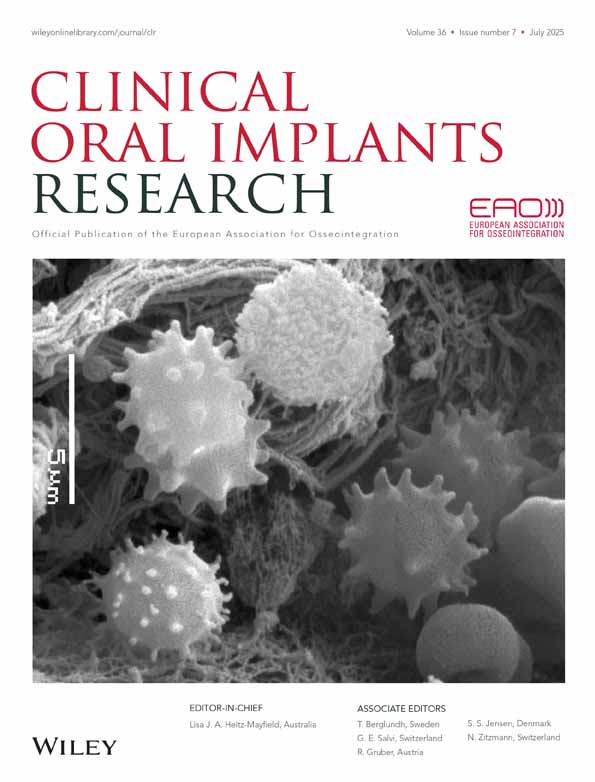Overdenture attachment selection and the loading of implant and denture-bearing area. Part 2: A methodical study using five types of attachment
Abstract
enAbstract: In general, an implant is loaded via axial and horizontal forces. Besides this, moment loading can also occur. The aim of this study was to investigate how different prosthetic connectors with overdentures develop force transfer to implant and bone as well as to the denture-bearing alveolar ridge. Five connectors were investigated on a stereolithographic model fabricated according to a real patient situation. The model was fitted with strain gauges on the “bone” distal and medial to the implants and with vertical force transducers in the alveolar “bone” under the denture-bearing area. The parallel-sided rigid telescopic connector developed the highest moment loading of the implant (P<0.001), which would suggest restraint in the use of this connector. The bar construction also showed somewhat high moments but these may have been at least partly exaggerated by the individual patient situation. Loading results through the non-rigid telescopic copings, single spherical attachments and magnet overdentures demonstrated a low level of implant moment loading which would in part result from horizontal forces caused by denture forward shift during force application. The denture-bearing area loading was different with all attachments (P<0.001) and was related to the rigidity of the connector and reached the highest values with the non-rigid telescopic coping. The clinical implications of the various findings are discussed.
Résumé
frEn général, un implant est soumis à des forces axiales et horizontales. Un moment de charge peut aussi se présenter. Le but de cette étude a été de vérifier comment différents connecteurs prothétiques développaient des forces transférées à l’implant et à l’os ainsi qu’à la branche alvéolaire soutenant la prothèse. Cinq connecteurs ont étéétudiés sur un modèle stéréolithographique fabriqué suivant une situation semblable à celle présente chez le patient. Le modèle a été ajusté avec des jauges de tension en distal et au milieu des implants, et avec des transducteurs de force verticale dans l’os alvéolaire sous la zone soutenant la prothèse. Le connecteur téléscopique rigide parallèle a développé la charge de tension la plus importante de l’implant (P<0.001) ce qui pourrait suggérer une restriction de l’utilisation de ce connecteur. La construction de barres montrait également des moments importants mais ces derniers pouvaient être partiellement exagérés par la situation individuelle de chaque patient. Les résultats de charge par les attaches téléscopiques non-rigides, les attaches sphériques unitaires, et les prothèses avec aimants démontraient un niveau faible de moment de charge de l’implant qui pouvait en partie résulter des forces horizontales causées par le déplacement durant l’application de la force. La charge dûe à la prothèse était différente avec toutes les attaches (P<0.001), était en relation avec la rigidité du connecteur et atteignait les valeurs les plus importantes avec l’attache téléscopique non-rigide. Les implications cliniques de ces différentes découvertes sont discutées.
Zusammenfassung
deIm allgemeinen wird ein Implantat durch axiale und horizontale Kräfte belastet. Dabei können auch Momentbelastungen auftreten. Es wäre demzufolge von Interesse, wie unterschiedliche hybrid-prothetische Verbindungselemente die Kräfte auf Implantat und Knochen sowie auf das prothesentragende Lager des Alveolarfortsatzes übertragen. Auf einem stereolithographischen Modell, das entsprechend einer realen Patientensituation erstellt worden war, wurden fünf Verbindungselemente untersucht. Das Modell wurde mit Dehnungsmess-Streifen auf dem »Knochen« distal und mesial der Implantate und mit vertikalen Kraftaufnehmern im »Alveolarknochen« unter dem prothesentragenden Lager ausgerüstet. Die paralellelwandigen starren Teleskopverbindungen (Zylinderteleskope) entwickelten die höchsten Belastungsmomente bei den Implantaten (P<0.001), weshalb bei der Verwendung der letzteren Zurückhaltung angebracht sei. Die Stegkonstruktion zeigte ebenfalls relativ hohe Belastungsmomente, wobei diese zumindest zum Teil durch die individuelle Patientensituation erhöht worden sein könnten. Die nicht-starren Teleskopverbindungen (Resilienzteleskope), Kugelanker und Magnet-verbindungen zeigten eine niedrige Momentanbelastung der Implantate. Diese dürfte z.T. aus horizontalen Kräften resultieren, die durch einen Vorwärtsschub der Prothese bei Belastung ausgelöst wurden. Die Belastung des prothesentragenden Lagers war bei allen zu untersuchenden Verbindungslementen verschieden (P<0.001) und erreichte bei der nicht-starren Teleskopverbindung den höchsten Wert. Die Lagerbelastung verhielt sich dabei in Relation zur Starrheit des Verbindungselements. Die klinischen Auswirkungen der gewonnenen Erkenntnisse werden diskutiert.
Resumen
esEn general, un implante se carga por via axial y con fuerzas horizontales. Aparte de esto, también puede ocurrir un momento de carga. La intención de este estudio fue investigar como diferentes conectores prostéticos con sobredentaduras desarrollan transferencias de fuerzas al implante y al hueso al igual que a la cresta alveolar que soporta a la dentadura. Se investigaron cinco conectores en un modelo estereolitográfico fabricado de acuerdo con una situación real de paciente. Se acoplaron sensores de strain al modelo sobre el hueso distal y mesial a los implantes y con transductores de fuerza vertical en el hueso alveolar bajo el área de soporte de la dentadura. El conector telescópico de lados paralelos rigidos desarrolló el mayor momento de carga del implante (P<0.001), lo cual sugiere un uso restringido de este conector. La construcción en barra también mostró unos momentos algo altos pero estos pueden haber sido al menos parcialmente exagerados por la situación individual del paciente. Los resultados da la carga a través de las coronas telescópicas no rígidas, ataches unitarios simples de bola y sobredentaduras magnéticas demostraron un bajo nivel de momento de carga implantário que puede en parte resultar de fuerzas horizontales causadas por desplazamiento hacia delante de la dentadura durante la aplicación de fuerzas. La carga del área de soporte de la dentadura fue diferente con todos los ataches (P<0.001) y se relacionó con la rigidez del conector y alcanzó los valores mas altos con las coronas telescóipicas no rigidas. Las implicaciones clinicas de los diferentes hallazgos se discuten.




